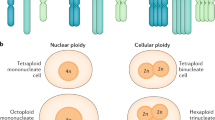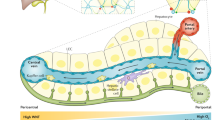Abstract
Polyploidisation in hepatocytes has been associated with many physiologic and pathologic processes such as proliferation, metabolism, regeneration, aging, and cancer. We studied gene expression patterns in hepatocytes of different ploidy. Primary hepatocytes were obtained from mice of different ages: young (4–6 weeks old), adult (8–10 weeks old), and older (22–24 weeks old). Diploid (2N), tetraploid (4N), and octoploid (8N) hepatocytes were isolated for studies using a high-density mouse genome microarray. No major changes of gene expression patterns between hepatocytes of different ploidy were found. Fifty genes were identified as differentially expressed in the diploid and tetraploid populations, but the changes were less than twofold either way. Four genes (Gas2, Igfbp2, Nr1i3, and Ccne2) were differentially expressed in tetraploid and octoploid cells. This was confirmed in two age groups, “adult” and “older,” but once again the factors were less than twofold and the expressions of Gas2 and Igfbp2 were more different between age groups than between ploidy classes. Our results show that polyploid hepatocytes are stable and “normal” without aberrant gene expression, unlike what is thought for cancer cells. By contrast to megakaryocytes, hepatocyte polyploidisation is not a differentiation step associated with major changes in gene expression. Our data support the hypothesis that hepatocyte polyploidisation is a protective mechanism against oxidative stress that occurs via a controlled process throughout growth and aging where binucleation is important.



Similar content being viewed by others
References
Adams KL, Wendel JF (2005) Novel patterns of gene expression in polyploid plants. Trends Genet 21:539–543
Amin S, Riggs BL, Atkinson EJ, Oberg AL, Melton LJ III, et al. (2004) A potentially deleterious role of IGFBP-2 on bone density in aging men and women. J Bone Miner Res 19:1075–1083
Anatskaya OV, Vinogradov AE (2007) Genome multiplication as adaptation to tissue survival: evidence from gene expression in mammalian heart and liver. Genomics 89:70–80
Andreassen PR, Lohez OD, Lacroix FB, Margolis RL (2001) Tetraploid state induces p53-dependent arrest of nontransformed mammalian cells in G1. Mol Biol Cell 12:1315–1328
Arnerlöv C, Emdin SO, Cajander S, Bengtsson NO, Tavelin B, et al. (2001) Intratumoral variations in DNA ploidy and s-phase fraction in human breast cancer. Anal Cell Pathol 23:21–28
Barbason H, Van Cantfort J, Houbrechts N (1974) Correlation between tissue and division fuctions in the liver of young rats. Cell Tissue Kinet 7:319–326
Bellamy COC, Clarke AR, Wyllie AH, Harrison DJ (1997) p53 deficiency in liver reduces local control of survival and proliferation, but does not affect apoptosis after DNA damage. FASEB J 11:591–599
Benetti R, Del Sal G, Monte M, Paroni G, Brancolini C, et al. (2001) The death substrate Gas2 binds m-calpain and increases susceptibility to p53-dependent apoptosis. EMBO J 20:2702–2714
Bohm N, Noltemeyer N (1981) Excessive reversible phenobarbital induced nuclear DNA-polyplodization in the growing mouse liver. Histochemistry 72:63–74
Brancolini C, Bottega S, Schneider C (1992) Gas2, a growth arrest-specific protein, is a component of the microfilament network system. J Cell Biol 117:1251–1261
Bucher NLR (1963) Regeneration of the mammalian liver. Liver Int Rev Cytol 15:245–300
Chabicovsky M, Herkner K, Rossmanith W (2003) Overexpression of activin βC or activin βE in the mouse liver inhibits regenerative deoxyribonucleic acid synthesis of hepatic cells. Endocrinology 144:3497–3504
Chen YG, Liu HM, Lin SL, Lee JM, Ying SY (2002) Regulation of cell proliferation, apoptosis, and carcinogenesis by activin. Exp Biol Med 227:75–87
Chipchase MD, O’Neill M, Melton DW (2003) Characterisation of premature liver polyploidy in DNA repair (Ercc1)-deficient mice. Hepatology 38:958–966
Cimini D, Tanzarella C, Degrassi F (1999) Differences in malsegregation rates obtained by scoring ana-telophase or binucleated cells. Mutagenesis 14:563–568
Dallman PR, Spirito RA, Siimes MA (1974) Diurnal patterns of DNA synthesis in the rat: modification by diet and feeding schedule. J Nutr 104:1234–1241
Fujikawa-Yamamoto K, Zong ZP, Murakami M, Odashima S, Ikeda T, et al. (1997) Spontaneous polyploidization results in apoptosis in a Meth-A tumor cell line. Cell Struct Funct 22:399–405
Galipeau PC, Cowan DS, Sanchez CA, Barrett MT, Emond MJ, et al. (1996) 17p(p53)allelic losses, 4N (G2/tetraploid) populations, and progression to aneuploidy in Barrett’s esophagus. Proc Natl Acad Sci U S A 93:7081–7084
Galitski T, Saldanha AJ, Styles CA, Lander ES, Fink GR (1999) Ploidy regulation of gene expression. Science 285:251–254
Gerhard HB, Schultze B, Maurer W (1971) Cell classes and ploidy distribution of isolated mouse liver cells. Exp Cell Res 69:223–226
Glotzer M (2005) The molecular requirements for cytokinesis. Science 307:1735–1739
Gorla GR, Malhi H, Gupta S (2001) Polyploidy associated with oxidative injury attenuates proliferative potential of cells. J Cell Sci 114:2943–2951
Grellier P, Berrebi D, Peuchmaur M, Babajko S (2002) The IGF system in neuroblastoma xenografts: focus on IGF-binding protein-6. J Endocrinol 172:467–476
Guidotti JE, Bregerie O, Robert A, Debey P, Brechot C, et al. (2003) Liver cell polyploidisation: A pivotal role for binuclear hepatocytes. J Biol Chem 278:19095–19101
Gupta S (2000) Hepatic polyploidy and liver growth control. Semin Cancer Biol 10:161–171
Hasmall SC, Roberts RA (1997) Hepatic ploidy, nuclearity, and distribution of DNA synthesis: a comparison of nongenotoxic hepatocarciogens with noncarcinogenic liver mitogens. Toxicol Appl Pharmacol 144:287–293
Hully JR, Chang L, Schwall RH, Widmer HR, Terrell TG, et al. (1994) Induction of apoptosis in the murine liver with recombinant human activin-A. Hepatology 20:854–862
Jones MR, Ravid K (2004) Vascular smooth muscle polyploidization as a biomarker for aging and its impact on differential gene expression. J Biol Chem 279:5306–5313
Kirschner K, Singh R, Prost S, Melton DW (2007) Characterisation of ERCC1 deficiency in the liver and conditional ERCC1-deficient primary hepatocytes in vitro. DNA Repair (Amst) 6:304–316
Kudryavtasev BN, Kudryavtseva MV, Sakuta GA, Stein GI (1993) Human hepatocyte polyploidization kinetics in the course of life cycle. Virchows Arch B Cell Pathol Incl Mol Pathol 64:387–393
Levine DS, Sanchez CA, Rabinovitch PS, Reid BJ (1991) Formation of the tetraploid intermediates is associated with the development of cells with more than four centrioles in the elastase-simian virus 50 tumor antigen transgenic mouse model of pancreatic cancer. Proc Natl Acad Sci U S A 88:6427–6431
Margolis RL, Lohez OD, Andreassen PR (2003) G1 tetraploidy checkpoint and the suppression of tumorigenesis. J Cell Biochem 88:673–683
Minamishima YA, Nakayama K, Nakayama KI (2002) Recovery of liver mass without proliferation of hepatocytes after partial hepatectomy in Skp2-deficient mice. Cancer Res 62:995–999
Moore LB, Parks DJ, Jones SA, Bledsoe RK, Consler TG, et al. (2002) Orphan nuclear receptors constitutive androstane receptor and pregnane X receptor share xenobiotic and steroid ligands. J Biol Chem 275:15122–15127
Möröy T, Geisen C (2004) Cyclin E. Intl J Biochem Cell Biol 36:1424–1439
Pascussi JM, Gerbal-Chaloin S, Drocourt L, Maurel P, Vilarem MJ (2003) The expression of CYP2B6, CYP2C9 and CYP3A4 genes: a tangle of networks of nuclear and steroid receptors. Biochim Biophys Acta 1619:243–253
Quarrie JK, Riabowol KT (2004) Murine models of life span extension. Sci Aging Knowledge Environ 31:re5
Rajvanshi P, Liu D, Ott M, Gapandeep S, Schilsky M, et al. (1998) Ploidy-based fractionation of rat hepatocytes with varying metabolic potential, proliferative capacity and retroviral gene transfer. Exp Cell Res 244:405–419
Raslova H, Kauffmann A, Sekkai D, Ripoche H, Larbret F, et al. (2007) Interrelation between polyploidization and megakaryocyte differentiation: a gene profiling approach. Blood 109:3225–3234
Roh M, Song C, Kim J, Abdulkadir SA (2005) Chromosomal instability induced by Pim-1 is passage-dependent and associated with dysregulation of cyclin B1. J Biol Chem 280:40568–40577
Rosenzweig SA (2004) What’s new in the IGF-binding proteins? Growth Horm IGF Res 14:329–336
Saeter G, Lee CZ, Schwarze PE, Ous S, Chen DS, et al. (1988) Changes in ploidy distributions in human-liver carcinogenesis. J Natl Cancer Inst 80:1480–1485
Sanz N, Diezfernandez C, Fernandezsimon L, Alvarez A, Cascales M (1995) Relationship between antioxidant systems, intracellular thiols and DNA-ploidy in liver of rats during experimental cirrhogenesis. Carcinogenesis 16:1585–1593
Schmucker DL (1998) Aging and the liver. J Gerontol Ser A Biol Sci Med Sci 53:B315–B320
Seglen PO (1997) DNA ploidy and autophagic protein degradation as determinants of hepatocellular growth and survival. Cell Biol Toxicol 13:301–315
Shimokawa I, Higami Y, Tsuchiya T, Otani H, Komatsu T, et al. (2003) Life span extension by reduction of the growth hormone-insulin-like growth factor-1 axis: relation to caloric restriction. FASEB J 17:1108–1109
Sigal SH, Rajvanshi P, Gorla GR, Sokhi RP, Saxena R, et al. (1999) Partial hepatectomy-induced polyploidy attenuates hepatocytes replication and activates cell aging events. Am J Physiol Gastrointest Liver Physiol 276:G1260–G1272
Storchova Z, Pellman D (2004) From polyploidy to aneuploidy, genome instability and cancer. Nat Rev Mol Cell Biol 5:45–54
Swales K, Negishi M (2004) CAR, driving into the future. Mol Endocrinol 18:1589–1598
Torres S, Diaz BP, Cabrera JJ, Diaz-Chico JC, Diaz-Chico BN, et al. (1999) Thyroid hormone regulation of rat hepatocyte proliferation and polyploidization. Am J Physiol Gastrointest Liver Physiol 276:G155–G163
Toyoda H, Bregerie O, Vallet A, Nalpas B, Pivert G, et al. (2005) Changes to hepatocyte ploidy and binuclearity profiles during human chronic viral hepatitis. Gut 54:297–302
Vendrell E, Morales C, Risques R, Capella G, Peinado MA (2005) Genomic determinants of prognosis in colorectal cancer. Cancer Lett 221:1–9
Yasuda H, Mine T, Shibata H, Eto Y, Hasegawa Y, et al. (1993) Activin-A – an autocrine inhibitor of initiation of DNA-synthesis in rat hepatocytes. J Clin Invest 92:1491–1496
Acknowledgments
The authors thank Shonna Johnston of the Centre for Inflammation Research, University of Edinburgh, for helping with flow-sorting; Garry Beran and Johanna Loughlin for helping with microarray operation; Dr. Kevin Roberston of the Scottish Centre for Genomic Technology and Informatics for helping with the operation of the Agilent Bioanalyzer and initial microarray data analysis; Wellcome Trust Clinical Research Facility, Edinburgh, for providing the real-time PCR facility and technical support. This project was funded by Safety Assessment UK, AstraZeneca, and University of Edinburgh.
Author information
Authors and Affiliations
Corresponding author
Rights and permissions
About this article
Cite this article
Lu, P., Prost, S., Caldwell, H. et al. Microarray analysis of gene expression of mouse hepatocytes of different ploidy. Mamm Genome 18, 617–626 (2007). https://doi.org/10.1007/s00335-007-9048-y
Received:
Accepted:
Published:
Issue Date:
DOI: https://doi.org/10.1007/s00335-007-9048-y




